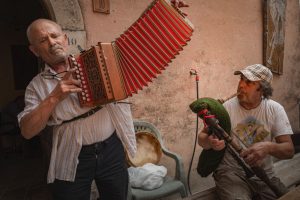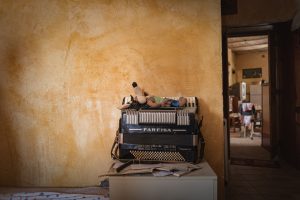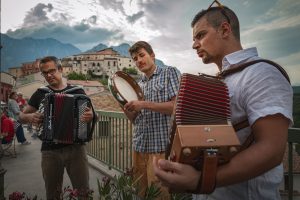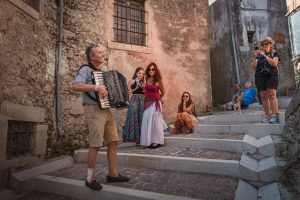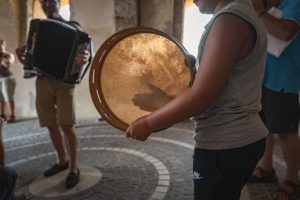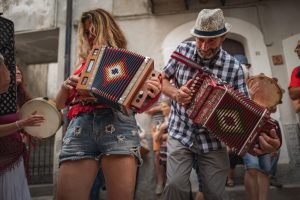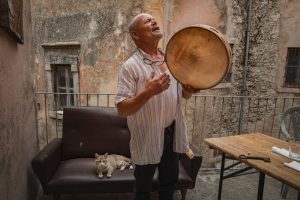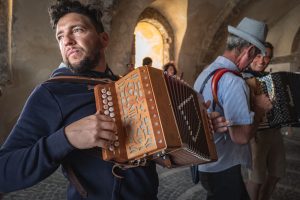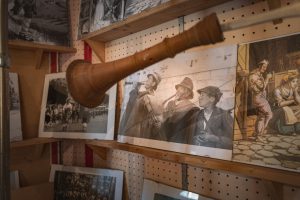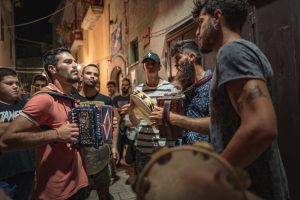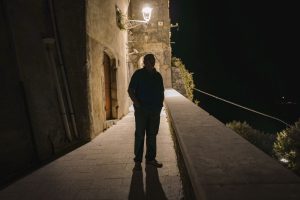SCAPOLI
Molise, one of the smallest regions in Italy, only two provinces: Campobasso and Isernia. Small municipalities with very low population density. For years now, young people have been emigrating and those who remained, follow the rhythm of tradition. Even small ethnic-linguistic minorities can still be found in the territory, where Albanian and Molisan-Croatian are still spoken.
A different Italy, an environment not contaminated by the pollution that deteriorate most of the Italian territory. One highway and a myriad of small villages scattered in a hidden region. An ancient history, starting from the Samnites leading to our current days, an history crossed by the deeds of the Templars, and then the tratturi (grass pathways), the transhumance. Ancient rituals handed down during festivals, carnivals and popular events that actively involve the inhabitants of these places.
With my project I want to document one of the traditions that has its roots in the past and that the International Festival of Bagpipes commemorate every year since 1975, in Scapoli, the last weekend of July.
Scapoli, (Isernia) is a town 600 meters above sea level, is important for having preserved the ancient techniques of the construction of bagpipes, using different woods such as the olive tree, the plum tree and the cherry tree. The Bagpipe, once named “utriculus” (small goatskin) was used by shepherds as a means of communication. A continuous sound made possible thanks to the reserve of air stored in the bag.
In Scapoli the bagpipes are not only played, but above all they are manifactured in artisan laboratories thanks to highly skilled “masters of art”: real engineers of the “utriculus”.
And this is where the festival was born, where cultures, traditions and bagpipers coming from all over the world meet. A fantastic feast that keeps busy and involved the whole town for two days of meetings and concerts where bagpipes, ciaramelle, ethnic aerophones and other accompanying instruments are protagonists. Vibrant instruments played by Scots, Galicians, Andalusians, Andeans, and inhabitants of other Italian regions where the tradition of the bagpipe is still alive.
From my mother’s tales, I remember my grandparents, who died shortly after my birth. Today the only thing left are old photographs and my pilgrimage to those places in the research of my roots. Central Italy is the place where my maternal grandparents were born; their life begun there. As for many others, their life was marked by the abandonment of their own land in search of a “better” life in the north or in America.
Meeting those faces, looking at the eyes of the elderly, listening to their stories, all the same, but every time touching and emotional, because it is as if they were heard for the first time.
Human souls mix up with musical notes along the streets; colors that never quieten, either by day or by night and we are all fed by rhythm, dancing over the sound of bagpipes, tambourines, accordions, ciaramelle, friction drums and castanets until late night.
This is the music. Artisan workshops and their artists display the instruments they have handcrafted and from an open door of a house an accordion is heard playing and a deep voice of a Molisan man sings a folksong.
SCAPOLI
Molise, una delle regioni più piccole d’Italia, due sole provincie: Campobasso e Isernia. Piccoli comuni con bassissima densità abitativa. Ormai da anni, i giovani emigrano e quelli che restano assecondano i ritmi delle tradizioni. Resistono nel territorio anche piccole minoranze etnico-linguistiche dove è ancora parlato l’albanese e il croato molisano.
Un’altra Italia, un ambiente naturale intatto, quasi incontaminato dall’inquinamento che degrada gran parte del territorio italiano. Un’unica autostrada e un mare di piccoli paeselli sparsi in una regione nascosta, L’antichissima storia dai Sanniti ai giorni nostri attraversata dalle gesta dei templari, e poi i tratturi, la transumanza. Riti antichi che si tramandano durante festival, carnevali ed eventi popolari che coinvolgono fattivamente gli abitanti di questi luoghi.
Con il mio lavoro voglio documentare una delle tante tradizioni che risalgono al passato e che Il Festival Internazionale della Zampogna perpetua ogni anno dal 1975, a Scapoli, l’ultimo weekend di Luglio.
Scapoli (Isernia) è un paese a 600 metri di altitudine, importante per aver conservato le antiche tecniche della costruzione della zampogna che prevedono l’utilizzo di diverse essenze di legno, quali l’ulivo, il prugno e il ciliegio. La Zampogna, o anticamente chiamata “ utriculus” (piccolo otre), era usato dai pastori come mezzo di comunicazione. Un suono continuo grazie alla riserva d’aria conservata nella sacca.
A Scapoli le zampogne si suonano, ma soprattutto si creano nei laboratori artigianali grazie ad abilissimi “maestri d’arte”, veri e propri ingegneri degli “utriculus”.
Ed è qui che nasce questo festival, dove s’incontrano culture e tradizioni di zampognari che provengono da tutto il mondo. Una fantastica festa che occupa e coinvolge tutto il paese per due giorni ricchi di incontri e concerti dove i protagonisti sono zampogne, ciaramelle, cornamusa e aerofoni etnici e altri strumenti d’accompagnamento fatti vibrare da scozzesi, galiziani, andalusi, andini e da abitanti di regioni italiane dove la tradizione della cornamusa è ancora viva.
Ricordo i miei nonni, che sono morti poco dopo la mia nascita, dai racconti lontani di mia madre; oggi non mi rimangono che vecchie fotografie e il mio pellegrinaggio verso quei luoghi in cerca delle mie radici. Il centro Italia è il luogo dove nacquero i miei nonni materni; lì iniziò la loro vita che, come per tanti altri, fu segnata dall’abbandono della propria terra in cerca di una vita “migliore” su al nord o in America.
Ritrovare quei volti, scrutare gli occhi degli anziani, ascoltare le loro storie, tutte uguali, ma che commuovono ogni volta perché e come se fosse la prima volta che vengono udite.
Lungo le strade, l’animo umano si mescola alle note; i colori che non si placano né di giorno né di notte e ci si nutre di ritmi, danzando al suono delle zampogne, dei tamburelli, degli organetti, delle ciaramelle, dei tamburi a frizione, delle nacchere fino a tarda sera.
Questa è la musica. Le botteghe con i loro artisti espongono gli strumenti che hanno creato e dalle porte aperte delle case si ode una fisarmonica che inizia a suonare e la voce profonda di un molisano che intona un canto popolare.

